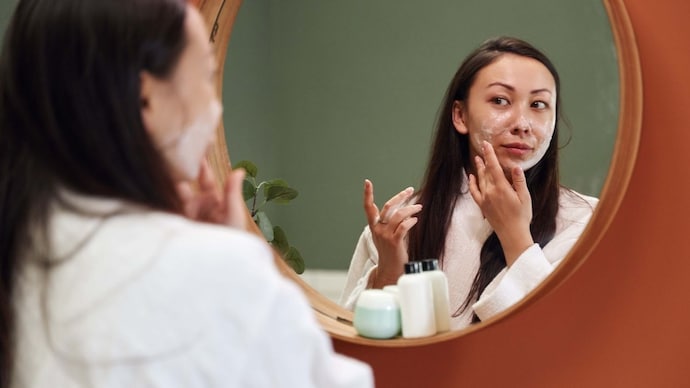If you're planning to build a skincare routine but are unsure about how many steps it should include, here's a simple guide to help you.

Regular skincare can help resolve skin concerns (Photo: Getty Images)
Whether you're a minimalist who swears by a single moisturiser or a dedicated skincare enthusiast with an elaborate routine, taking care of your skin is essential. If you're unsure where to start, just hop onto any social media platform, and you will find many influencers to give you skincare gyaan.
The beauty industry is constantly evolving, bringing global trends to the forefront. One day, a revolutionary 7-step skincare routine might be all the rage, only to be overshadowed the next by a comprehensive 10-step Korean regimen.
Meanwhile, some experts advocate just a simple cleansing, toning, and moisturising (CTM) routine.
Choosing the right skincare routine and determining how many steps it should include can be daunting. But don't worry, experts are here to guide you through the process. But first, understand...
Why is skincare so important?
"Skin acts as a barrier against the harmful toxins present in the environment such as chemicals, pollutants, bacteria, and damaging UV rays. This is why it is important to incorporate skincare into your daily routine to nourish your skin," Dr Rinky Kapoor, a Delhi-based dermatologist from The Esthetic Clinics, tells India Today.
- Dr Kapoor adds that a regular skincare regime can help resolve skin concerns such as acne, ageing spots, wrinkles, fine lines, dark circles, and flare-ups.
- As you age, the production of skin collagen and elastin decreases, making your skin appear saggy and loose. Maintaining a proper skincare routine can also help with that.
Adding to this, Dr Ruby Sachdev, consultant aesthetic physician, Gleneagles Hospital, Bengaluru, says that a good skincare regimen can enhance your overall appearance, boosting confidence and self-esteem.
Having an extensive routine
Dr Akanksha Singh Cornuit, Bengaluru-based aesthetic physician and founder of Promed Aesthetics, believes that the necessity of an extensive skincare routine depends on individual skin needs and preferences. While some people might benefit from a multi-step routine, it's not essential for everyone.
Meanwhile, Dr Kapoor mentions that several factors contribute to the popularity of extensive skincare routines, such as the increasing influence of K-beauty and people starting to prioritise their skin health.
"It doesn't matter how extensive your routine is; what matters the most is that it addresses all the skin problems with the correct skincare products that work effectively on your skin. Doing an extensive skincare routine daily can be time-consuming and may not be suitable for everyone, especially those with busy schedules," she adds.
More steps mean more products, which can be expensive and might burn a hole in your pocket.
If you follow a too-short routine
According to Dr Sachdev, basic moisturisation is a critical component of skincare and can be sufficient for many individuals, especially those with normal to healthy skin.
- However, a minimal routine may lack essential steps such as cleansing, sun protection, and treatment of specific skin issues.
- Neglecting these aspects can lead to clogged pores, sun damage, and other skin problems over time.
- So, it's important to ensure that even a minimal routine addresses the fundamental needs of the skin.
Dr Cornuit agrees and says, "If someone has specific skin concerns such as acne, hyperpigmentation, or signs of ageing, a more tailored routine may be needed to address these issues effectively. Relying solely on moisturiser may not provide the necessary active ingredients to treat these conditions."
How many steps do you actually need?
Experts feel that the ideal number of steps in a skincare routine varies depending on individual needs, skin type, concerns, and lifestyle. You can classify skincare routines into three categories:
Minimalistic routine (3-4 steps)
- Cleansing: This is the foundation of any skincare routine. Cleansing removes dirt, oil, and impurities that accumulate on the skin throughout the day and night. It helps prevent clogged pores and acne, and allows subsequent skincare products to penetrate better.
- Moisturising: This step is essential for maintaining skin hydration and barrier function. A good moisturiser helps lock in moisture, keeping the skin soft and supple, and can prevent dryness and irritation.
- Sun protection: Perhaps the most critical step in the morning routine. Sunscreen protects the skin from harmful UV rays that cause premature ageing, pigmentation, and increase the risk of skin cancer. It is vital to use a broad-spectrum SPF 30 or higher daily.
- Toning (optional): For some, adding a toner can help balance the skin's pH and remove any residual impurities post-cleansing. Toners can also provide additional hydration and prep the skin for better absorption of serums and moisturisers.
Intermediate routine (5-6 steps)
- Cleansing: Remember, it is a crucial first step.
- Toning: To further refine and prep the skin.
- Serum: Serums contain concentrated active ingredients that target specific skin concerns, such as Vitamin C for brightening, hyaluronic acid for hydration, or retinoids for anti-ageing. They penetrate deeply and deliver high-potency benefits.
- Moisturising: To lock in the benefits of serums and keep the skin hydrated.
- Sun protection: For daytime routines.
Advanced Routine (7+ steps)
- Double cleansing: Especially at night, start with an oil-based cleanser to remove makeup and sunscreen, followed by a water-based cleanser to clean the skin thoroughly.
- Exfoliation: 1-2 times a week, using chemical exfoliants (like AHAs or BHAs) or gentle physical exfoliants to remove dead skin cells, promote cell turnover, and keep the skin smooth and clear.
- Essence: Lightweight, hydrating liquids that enhance the absorption of serums and provide additional hydration and nutrients.
- Serums and ampoules: Targeted treatments for specific skin issues, applied after cleansing and toning.
- Sheet masks: Use occasionally to give the skin an intensive boost of hydration and nutrients.
- Eye cream: Specifically formulated to address the delicate skin around the eyes, targeting issues like dark circles, puffiness, and fine lines.
- Moisturising and sun protection
When building a skincare routine, consider the following:
- Skin type: Identify whether your skin is oily, dry, combination, or sensitive, and choose products accordingly.
- Skin concerns: Address specific issues like acne, pigmentation, or ageing with targeted treatments.
- Product ingredients: Opt for products with beneficial ingredients suitable for your skin type and concerns.
- Simplicity: Start with a basic routine and gradually introduce new products to monitor their effects on your skin.
- Consistency: Regular use of skincare products is crucial for seeing results.
Further, experts mention that your morning and evening skincare routines should not be identical because they serve different purposes and address varying skin needs at different times of the day.
Morning routine: The focus of this routine is on protecting the skin from environmental aggressors like UV rays, pollution, and free radicals. It typically includes cleansing, moisturising, and applying sunscreen. Additional products may include antioxidants like Vitamin C to combat oxidative stress.
Evening routine: Emphasises repairing and rejuvenating the skin after exposure to harmful elements throughout the day. It often involves cleansing to remove makeup, sunscreen, and impurities, followed by treatments that promote skin repair, such as retinoids, peptides, and hydrating serums.
Age-wise Breakdown
- Teen skin needs: Dr Sachdev mentions that during teenage years, skincare should focus on establishing good habits and managing common issues like acne and oiliness.
Cleansing, moisturising, and SPF should be sufficient. Toners and spot treatments can also be added to the routine.
- 20s skin needs: Dr Kapoor explains that in your 20s, you might want to focus more on skin problems like uneven skin tone, clogged pores, and dark circles.
Using a gentle cleanser daily can help eliminate the impurities and dirt from your skin. It is advised to regularly use sunscreen with an SPF of 30 or more for better coverage and protection from harmful UV rays.
Your ideal skincare routine in your 20s should include a cleanser, moisturiser, sunscreen, toner, and exfoliation once a week.
- 30s skin needs: In your 30s, your skin needs to shift to retaining moisture, addressing sun spots due to not following a proper skincare routine in your early 20s, and combating the loss of skin elasticity resulting in fine lines and wrinkles.
Incorporating skincare products that contain retinoids or peptides can help boost collagen production and reduce the appearance of ageing signs.
In your 30s, your skincare routine should contain products like hydrating cleansers to maintain moisture, moisturisers to fight against skin dryness, serum with peptide or retinoid for anti-ageing treatment, and sunscreen.
- 40s skin needs: As you age, the skin starts to lose its firmness and experience increased dryness. Use products that contain ingredients like hyaluronic acid and niacinamide to strengthen your skin barrier and maintain a youthful glow.
You should incorporate a skincare regime that includes a cleanser, exfoliation, serum, toner, under-eye cream, moisturiser, and SPF.
The key to achieving effective results is to be consistent with your skincare routine and use the right products to address specific skin concerns.
- 50s skin needs: In your 50s and above, address more advanced ageing concerns, hydration, and sensitivity. You can opt for a more extensive routine that includes exfoliation, essence, eye cream, and face oils.
Keep in mind
- Understand whether your skin is oily, dry, combination, sensitive, or normal. Your routine should address your specific concerns.
- Start with a basic routine and gradually add products if needed. A simple routine is easier to follow and reduces the risk of irritation.
- If you have specific concerns like acne, ageing, pigmentation, or sensitivity, incorporate targeted treatments such as serums or treatments.
- Before using new products, especially if they contain active ingredients, patch-test a small area to check for any adverse reactions.
- Introduce new products one at a time and give your skin time to adjust, especially with active ingredients like retinoids or acids.
- Pay attention to how your skin reacts to different products and adjust your routine accordingly. Not all products work for everyone.
- Stick to your routine consistently to see results. Skincare takes time, so be patient and give your routine a chance to work.
- Factors like diet, stress, and sleep can affect your skin. A healthy lifestyle complements your skincare routine.
Published By:
Mehak Malhotra
Published On:
Jun 19, 2024
Tune In













 English (US) ·
English (US) ·